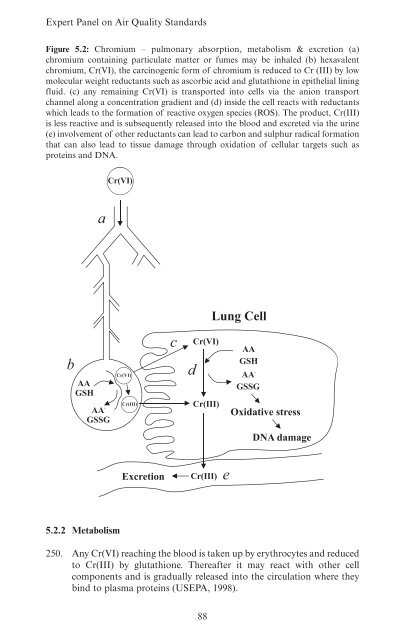Guidelines for Metals and Metalloids in Ambient ... - ARCHIVE: Defra
Guidelines for Metals and Metalloids in Ambient ... - ARCHIVE: Defra
Guidelines for Metals and Metalloids in Ambient ... - ARCHIVE: Defra
Create successful ePaper yourself
Turn your PDF publications into a flip-book with our unique Google optimized e-Paper software.
Expert Panel on Air Quality St<strong>and</strong>ards<br />
Figure 5.2: Chromium – pulmonary absorption, metabolism & excretion (a)<br />
chromium conta<strong>in</strong><strong>in</strong>g particulate matter or fumes may be <strong>in</strong>haled (b) hexavalent<br />
chromium, Cr(VI), the carc<strong>in</strong>ogenic <strong>for</strong>m of chromium is reduced to Cr (III) by low<br />
molecular weight reductants such as ascorbic acid <strong>and</strong> glutathione <strong>in</strong> epithelial l<strong>in</strong><strong>in</strong>g<br />
fluid. (c) any rema<strong>in</strong><strong>in</strong>g Cr(VI) is transported <strong>in</strong>to cells via the anion transport<br />
channel along a concentration gradient <strong>and</strong> (d) <strong>in</strong>side the cell reacts with reductants<br />
which leads to the <strong>for</strong>mation of reactive oxygen species (ROS). The product, Cr(III)<br />
is less reactive <strong>and</strong> is subsequently released <strong>in</strong>to the blood <strong>and</strong> excreted via the ur<strong>in</strong>e<br />
(e) <strong>in</strong>volvement of other reductants can lead to carbon <strong>and</strong> sulphur radical <strong>for</strong>mation<br />
that can also lead to tissue damage through oxidation of cellular targets such as<br />
prote<strong>in</strong>s <strong>and</strong> DNA.<br />
Cr(VI)<br />
a<br />
Lung Cell<br />
b<br />
AA<br />
GSH<br />
AA .<br />
GSSG<br />
Cr(VI)<br />
Cr(III)<br />
c<br />
d<br />
Cr(VI)<br />
Cr(III)<br />
AA<br />
GSH<br />
AA .<br />
GSSG<br />
Oxidative stress<br />
DNA damage<br />
Excretion<br />
Cr(III)<br />
e<br />
5.2.2 Metabolism<br />
250. Any Cr(VI) reach<strong>in</strong>g the blood is taken up by erythrocytes <strong>and</strong> reduced<br />
to Cr(III) by glutathione. Thereafter it may react with other cell<br />
components <strong>and</strong> is gradually released <strong>in</strong>to the circulation where they<br />
b<strong>in</strong>d to plasma prote<strong>in</strong>s (USEPA, 1998).<br />
88
















